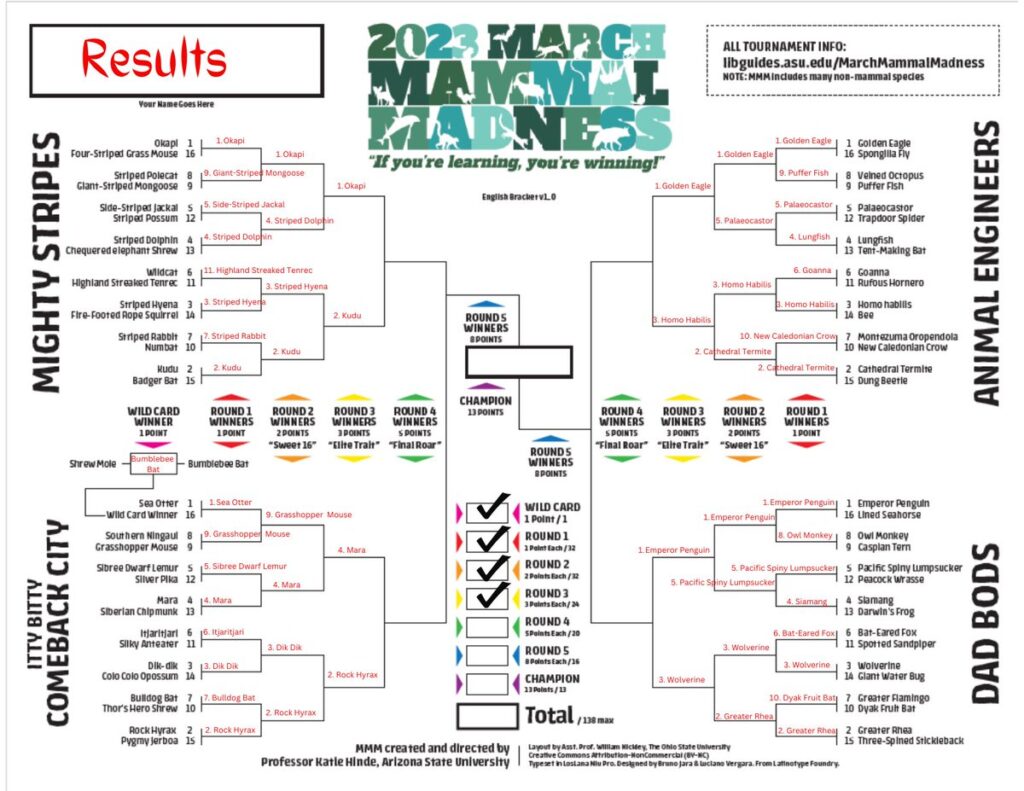By Myah Hesselgesser and Ananya Sharma, Staff Writers
March Mammal Madness is an event based on the March Madness basketball tournament that takes place in the month of March. Instead of basketball teams competing against each other, in March Mammal Madness 64 different species of animals compete together in computer simulated combat.
The March Mammal Madness bracket is directly modeled after the NCAA championship one. It is divided into 4 divisions, which change every year. This year, the divisions are Mighty Stripes , Itty Bitty Comeback City, the Animal Engineers, and Dad Bods. The animals are divided into separate divisions based on their unique characteristics. They compete against the other animals in their division, and fight to make it to the Final Four, which consists of one animal from each division, and finally the championship.
The battles between the animals are simulated on a computer, and the winners are decided using a combination of scientific research and luck. Katie Hinde, the founder of March Mammal Madness, and her team do in depth research of each contestant. They use many factors, such as the temperament, diet, social behavior, environment, size, and fight style of the animal, to decide which one has the greater probability of winning. The element of chance is a crucial factor in real life fights, so the team also takes this into account. The team then creates a simulation of the fight and a story of how one animal won.
This event is very popular among students and educators, and it is a great way to teach people about biology. River Hill science teachers Mr. Clifford and Mrs. Wester also incorporate March Mammal Madness into their classes. According to Mrs. Wester, “I have one winner for each of my classes and then we also take our results and compare our two teams.” Mr. Clifford’s classes are a part of Team Otter, and Mrs. Wester’s classes are Team Moose. So far the Otters are winning, but the competition is very close and the results could change soon.
March Mammal Madness is a very engaging experience for students. Mrs. Wester commented, “People remember it from the previous years, and there will always be a couple of kids who stop by. People like it, you know, these are the long days of winter and we all have to make it to spring break. So this is what’s nice about it. Three days a week, we get to come in and look at the results. And for like 10 minutes there’s something a little different.”
Sophomore Rhea Nair said, “My biology class last year did March Mammal Madness, and I still remember having fun and competing with my friends over who would get the most points at the end. I remember learning about a lot of different animals I’d never heard of before.”
Some of the current standings of animals in March Madness are Golden Eagle vs. Spongilla Fly, with Golden Eagle moving to the next round, Paleo fosser vs. Trapdoor Spider, with Paleo fosser moving to the next round, and Montezuma Oropendola vs. Caledonian Crow, with Caledonian Crow moving to the next round. Attached below is an updated bracket of the current standings:

The final round of March Mammal Madness will take place on April 5th, and while Mrs. Wester thinks the Golden Eagle will win, Mr. Clifford is going with the Sea Otter. He explained, “Towards the end, the ecology they’re fighting in is random. And this year, out of the four random ecologies they could be in, two of them are saltwater biomes. So I was like, if there is a year that the Sea Otter, which is my favorite animal of all time, could win, it’s this year.”
Rhea’s pick is the Wolverine, because “they seem like a powerful animal, and I think they have a big chance of winning this year.”
Overall, March Mammal Madness is a fun and engaging way to include everyone, even if they don’t like sports. Hopefully, March Mammal Madness will continue long into the future and hopefully create a title wave of inspiration and admiration in students to help spur their interest in biology and all things related to the animal kingdom .

